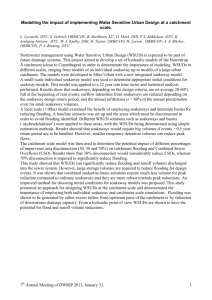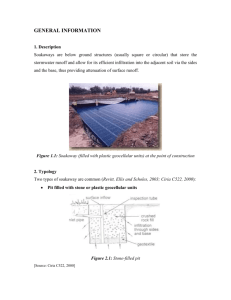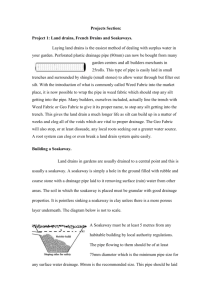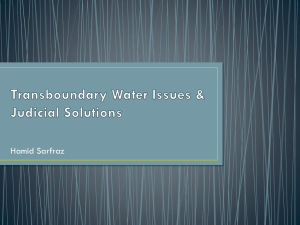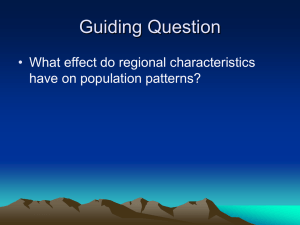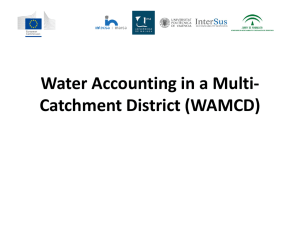Modelling the impact of implementing Water Sensitive Urban design
advertisement
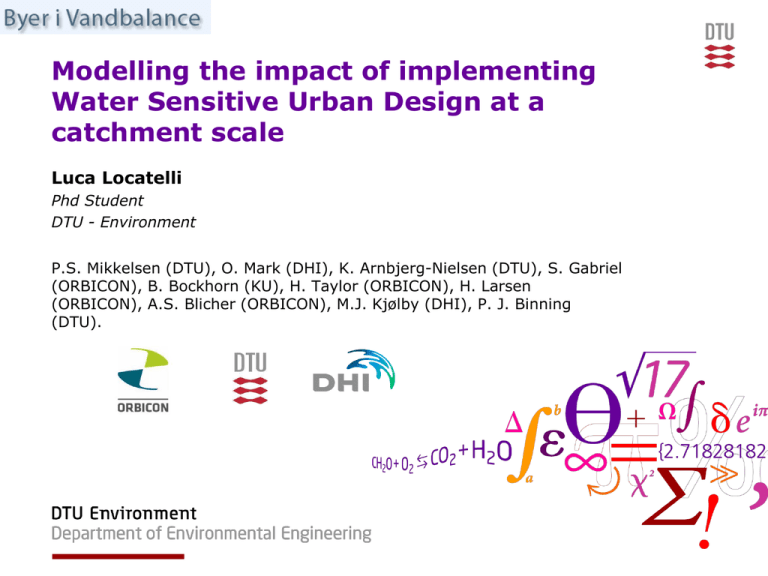
Modelling the impact of implementing Water Sensitive Urban Design at a catchment scale Luca Locatelli Phd Student DTU - Environment P.S. Mikkelsen (DTU), O. Mark (DHI), K. Arnbjerg-Nielsen (DTU), S. Gabriel (ORBICON), B. Bockhorn (KU), H. Taylor (ORBICON), H. Larsen (ORBICON), A.S. Blicher (ORBICON), M.J. Kjølby (DHI), P. J. Binning (DTU). Aim of the project To model the impact of retention-detention basins (’skybrudfaskiner’) • Annual water balance • Estimate initial conditions for single design events • Peak flow reduction on design events What are retention-detention basins (’skybrudfaskine’)? Why retention-detention basins? Detention storage handles design storm events (e.g. return period >2 year) Detention volume << retention volume Retention storage handles everyday events (e.g. return period <2 year) Retention storage reduces runoff volume Literature on detention-retention systems • Roldin, M.; O. Fryd; J. Jeppesen; O. Mark; P. J. Binning; P. S. Mikkelsen and M. B. Jensen. 2012. "Modelling the Impact of Soakaway Retrofits on Combined Sewage Overflows in a 3 Km(2) Urban Catchment in Copenhagen, Denmark." Journal of Hydrology, 452, pp. 64-75. • Roldin, Maria; Ole Mark; George Kuczera; Peter S. Mikkelsen and Philip J. Binning. 2012. "Representing Soakaways in a Physically Distributed Urban Drainage Model – Upscaling Individual Allotments to an Aggregated Scale." Journal of Hydrology, 414-415, pp. 530-38 • Sønderup, H.; J. Jørgen Linde; S. Gabriel and P.S. Mikkelsen. 2002. "Rainwater Tanks Are Less Efficient Than Detention Basins for Cso Abatement," Global solutions for urban drainage : 9ICUD, Portland, Oregon, 8-13 September 2002 • Jeppesen, Jan. 2010. "Quantitative Hydrological Effects of Urbanization and Stormwater Infiltration in Copenhagen, Denmark," PhD Thesis. Department of Earth Sciences, Aarhus University, Denmark Case study area 0.6 hectares of impervious area, k= 10-6 m/s Model (1) TOOL: MIKE URBAN (DHI) + Soakaway model (Roldin et al. 2012) METHOD: Single soakaways can be modelled as a single aggregated unit (Roldin et al. 2012) Model (2) THE SOAKAWAY MODEL (Roldin et al. 2012) Calculates the infiltration rates from a ’basin’ in Mike Urban Qin Qin QQ of of h Qf w l Method 1. Model Baseline scenario and identify the area to be disconnected Single event with 10 year return period 2. Model the annual water balance Soakaway model, continuous simulation using 22 years rainfall time series 3. Estimate initial conditions (water content) Soakaway model, continuous simulation using 22 year rainfall time series 4. Design the detention-retention basin and model it in Mike Urban Regional CDS Ver_3.2.xls + The retention-detention basin is modelled as a ’basin’ node in Mike Urban with an overflow pipe controlled by a maximum flow rate valve. Results Baseline scenario CDS rain with T=10 years and a safety factor of 1.1 Black nodes = water above terrain Depth below surface (m) Results (1) Can we reduce sewage overflow by disconnecting areas? 88% disconnected! Results (2) Annual water balance (1) Results (3) Annual water balance (2) Results (4) Initial conditions Results (5) Design retention-detention basins Detention-retention volume = 3.4 m3 per 100m2 of impervious area (impervious area = 0.6ha) Results (6) With combined detention-retention CDS rain with T=10 years and a safety factor of 1.1 Conclusions • Detention-retention basins can help avoid sewer surcharge • Detention-retention basins infiltrate a large percentage of the annual stormwater runoff smaller load to sewage treatment plant A soakaway design return period T= 0.1 years infiltrates approx. 80% of the annual stormwater runoff • Increasing soakaway volumes leads to diminishing returns in performance: the larger the design return period of soakaways the smaller the stormwater volume infiltrated per unit volume of soakaway • Soakaways are on average between 20% and 60% full at the beginning of the simulation. The higher the design return period the more likely the soakaway is empty at the beginning of the simulation. Thank you for your attention Luca Locatelli lulo@env.dtu.dk Results (3) Annual water balance (2)
